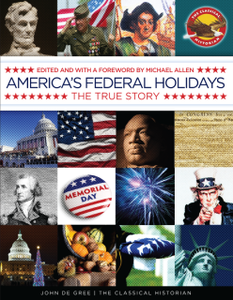Labor Day, the first Monday in September
Labor Day is celebrated on the first Monday of September. It is a holiday in honor of the workers of the United States of America. In the 1880s, various states and cities began to celebrate workers with parades. Labor Day is typically a celebration of the average city-worker, and was the culmination of a growing labor movement in American cities. It marked the end of a chiefly agrarian society in America and the beginning of a modern one. In 1894, President Grover Cleveland signed the Labor Day legislation into law. Contrary to Europe, celebration of the worker in America has primarily supported the free market and has not been a call for Socialism. This fact has its roots in Labor Day. It is challenging to remember life in the United States before the era of industrialization. 90% of Americans grew up and worked on farms before the second half of the 19th century, and up to World War II, most Americans were farmers. Life on a farm is often glamorized, with romantic visions of beautiful sunsets, sweet-smelling grass and corn, and quiet and peace. In reality, the workday for the typical farmhand in pre-industrial America was tough and often unpleasant. My Dad, my personal hero, grew up in 1930s and 40s Minnesota, a true Depression-baby farm boy. Starting at the age of 12 until he reached adulthood, he was hired out to a local family each summer to work on their farm. His experience was similar to most boys growing up in farm country, America. He lived in the family’s basement, Monday through Saturday. He awoke before dawn to feed the animals, clean the stalls, and continued to work throughout the day, as long as the sun was up. He did all the work a man would do, from driving tractors to repairing anything that would break. And, his workday was over 12 hours a day. When my Dad earned $1 a day, it was big money. He was able to use his summer earnings to pay for his school clothes, any books, and extra money throughout the school year. He was, in many ways, financially independent as a teenager. When American society changed from an agrarian society to an industrial one, families faced great challenges, both socially and economically. Whereas before, the family who owned a farm would work altogether, in a city, family members worked in different locations. Where most family farms were independently owned in the 1700s and 1800s, workers in cities didn’t own the businesses they worked in. And, because America was such a huge attraction to foreigners, city life offered a constantly changing society. In 1800s America, life for a factory worker was challenging. Workers had little or no rights, factories could be physically dangerous, and an evil business owner could get away with horrible acts. Workers could be killed by working in dangerous factories, or they could lose limbs and then be fired from their jobs. Still, the American worker most likely did better than other workers of the world. If this weren’t so, the U.S.A. wouldn’t have been the destination of so many millions of immigrants. The opportunity of America overrode the hardships of life when it came to where people wanted to live. Industrializing America lifted tens of millions out of poverty. Because of the harsh work conditions, labor leaders sought to gather workers into unions in order to bargain for worker rights. Initially in the United States and elsewhere, there was great opposition to worker rights both by the government and by business owners. Those in power feared that the workers would take away the power, rights, and property of the business owners. In Russia in 1917, a “Workers Party” called the Communists, did take away the property of individuals and went on to be responsible for the murder of tens of millions of Russians who opposed them. In the U.S.A., however, the labor movement focused on making the lives of workers better by pushing for an 8-hour workday, safer work conditions, and demanding fair treatment of all workers in every situation. In 1894, railway workers in the American Railway Union demanded better work conditions and went on strike against the Pullman Company. During the strike, the U.S. government attempted to crush the strike, as did other worker’s unions. There was violence, and workers died at the hands of government employees. This strike helped Americans realize that working conditions needed to drastically change for factory workers. President Cleveland and the U.S. Congress initially opposed the strike, but later realized that the workers’ demands were reasonable. The Pullman Company was forced to change in favor of the workers. In 1894, the U.S. government passed a law declaring the first Monday of September a national holiday to honor workers. Today, this holiday is also celebrated as a seasonal event, with families marking it as the end of summer and beginning of fall. The major labor movements in America remained true to the principles of liberty and respect for private property. Samuel Gompers founded the American Federation of Labor in the 1880s, one of the country’s largest and most important labor unions. As a labor leader, he strongly opposed Socialism and helped the American worker enjoy a quality standard of living without threatening the rights of property owners. Lesson Ideas for Grades k-5: 1. Ask children to think of all of the occupations, professions, and jobs they can think of. Make a list of them. 2. During dinner, have an adult in your family talk to the children about what he does every day at work and about other jobs he/she had. Lesson Idea for Grades 6-12: Direct your children to interview three people (one of them should own his own business) and ask five questions about the work he does. After the three interviews, have your children decide what sounds good about each of the three jobs and what sounds unpleasant. Have a short discussion about what type of work your child could imagine doing. Here are sample questions for the interview: a. Can you describe a typical day at work? b. What is the pay range of someone in your field? c. What are the highs and lows of your job? d. What type of education does someone need to have your job? e. If you could give me one piece of advice regarding my future work, what would it be?
3 Comments
Katie McCarthy
8/29/2019 08:43:05 am
This is great information! Thank you!!
Reply
9/5/2022 07:43:25 am
Thanks for these constructive lessons, John! We can trust that your curriculum is authentic at a time when history is being rewritten by those who want to tear down the USA.
Reply
Nicolee Hill
9/13/2022 01:26:19 pm
I agree with Katie, this is really great information. I am sorry I am just now seeing it. Thank you for sharing all of your knowledge with us!
Reply
Leave a Reply. |
John De GreeJohn De Gree writes the current events with a look at the history of each topic. Articles are written for the young person, aged 10-18, and Mr. De Gree carefully writes so that all readers can understand the event. The perspective the current events are written in is Judeo-Christian. Receive Articles and Coupons in Your EmailSign Up Now
For Email Marketing you can trust. Archives
June 2024
Categories
All
|
|
SUPPORT
|
RESOURCES
|
|



 RSS Feed
RSS Feed



